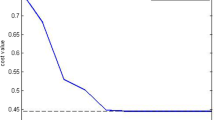Abstract
This paper builds upon the relationship between the objective function of a semi-infinite linear program and its constraints to identify a class of semi-infinite linear programs which do not have a duality gap. The key idea is to guarantee the approximation of the primal program by a sequence of linear programs where thenth approximating program is to minimize the objective function subject to the firstn constraints. The paper goes on to show that any program not in the identified class can be linearly perturbed into it with the optimal value of the perturbed program converging to the optimal value of the original program. The results are then extended to the case when an uncountable number of constraints are present by reducing this case to the countable case.
Similar content being viewed by others
References
J.M. Borwein, “The limiting Lagrangean as a consequence of Helly's Theorem”, unpublished manuscript.
J.M. Borwein, “A note on perfect duality and limiting Lagrangeans”,Mathematical Programming 18 (1980) 330–337.
A. Charnes, W.W. Cooper and K. Kortanek, “Duality in semi-infinite programs and some works of Haar and Carathéodory”,Management Science 9 (1963) 209–228.
A. Charnes, W.W. Cooper and K. Kortanek, “On representations of semi-infinite programs which have no duality gaps”,Management Science 12 (1965) 113–121.
A. Charnes, W.W. Cooper and K. Kortanek, “On the theory of semi-infinite programming and a generalization of the Kuhn—Tucker saddle point theorem for arbitrary convex functions”,Naval Research Logistics Quarterly 16 (1969) 41–51.
R.J. Duffin, “Infinite programs”, in‘ H.W. Kuhn and A.W. Tucker, eds.,Linear inequalities and related systems (Princeton University Press, Princeton, NJ, 1956) pp. 157–170.
R.J. Duffin, “Clark's Theorem on linear programs holds for convex programs”,Proceedings of the National Academy of Science, U.S.A. 75 (1978) 1624–1626.
R.J. Duffin and L.A. Karlovitz, “An infinite linear program with a duality gap”,Management Science 12 (1965) 122–134.
U. Eckhardt, “Theorems on the dimensions of convex sets”,Linear Algebra and its Applications 12 (1975) 63–76.
R.G. Jeroslow, “A limiting Lagrangian for infinitely-constrained convex optimization inR n”,Management Sciences Research Report No. 417, Carnegie—Mellon University (1978).
R.T. Rockafellar,Convex analysis (Princeton University Press, Princeton, NJ, 1970).
Author information
Authors and Affiliations
Additional information
Some of the results of this paper are in partial fulfillment of the requirements for the degree of Doctor of Philosophy.
Rights and permissions
About this article
Cite this article
Karney, D.F. Duality gaps in semi-infinite linear programming—an approximation problem. Mathematical Programming 20, 129–143 (1981). https://doi.org/10.1007/BF01589340
Received:
Revised:
Issue Date:
DOI: https://doi.org/10.1007/BF01589340




